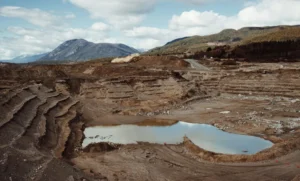Renewable and non-renewable resources are types of natural resources. Renewable resources can be naturally refilled over time, making them sustainable. Non-renewable resources, on the other hand, are finite and can eventually be drained.
Knowing the difference between these resources is important for responsible resource management and long-term environmental protection.
Renewable Resources
A renewable resource is a natural resource that can be replaced naturally over a short period. These resources regenerate through natural processes, such as the water cycle or sunlight.
Renewable resources can be renewed and are essential for maintaining ecological balance and supporting human needs without reducing the Earth’s reserves.
Which is a Renewable Resource?

A renewable resource is one that can be restocked naturally over time. Wind is a renewable resource. It is generated by atmospheric movements and can be used through wind turbines to produce electricity.
Examples include solar energy and hydropower. These resources are sustainable because they are naturally restored and do not run out.
Which resource is renewable?
Wind is an example of a renewable resource. Wind energy is generated by capturing the power of wind through turbines.
This energy source is renewable because wind is a natural, continuous force that does not reduce over time. Other examples of renewable resources include solar energy, hydropower, and biomass.
Which of the following is an example of a renewable resource?
Renewable resources can naturally regenerate. Here are some examples of a renewable resource:
Wind energy
- Wind is a renewable resource.
- It is generated by natural atmospheric movements and can be harnessed through wind turbines to produce electricity.
- Since wind is a constant and renewable force, it provides a sustainable energy source that can be used indefinitely without reduction.
- Wind energy is a main component of renewable energy strategies worldwide.
Solar energy
- The sun provides an endless supply of energy, making solar power a renewable resource.
- Solar energy is captured from the sun’s rays using solar panels.
- This energy is used using solar panels, which convert sunlight into electricity.
- Solar energy is plentiful and widely available, especially in regions with high sunlight exposure.
- It can highly reduce reliance on fossil fuels.
Hydropower
- The water cycle is a natural process driven by the sun’s heat, hydropower is renewable.
- Hydropower generates electricity by using the energy of flowing water. This is typically done through dams or water turbines.
- It is one of the most widely used sources of renewable energy, providing consistent and reliable power.
Geothermal energy
- Geothermal energy comes from the Earth’s internal heat.
- This heat is continuously generated, making geothermal energy a renewable resource.
- Geothermal energy is produced by tapping into the Earth’s internal heat, often using steam from underground reservoirs to generate electricity.
- Geothermal plants provide continuous energy output, independent of weather conditions.
Biomass
- Biomass energy is derived from organic materials such as wood, agricultural crops, and animal waste.
- These materials can be burned or converted into biofuels like ethanol.
- Since plants can regrow and waste is continually produced, biomass is considered a renewable resource.
- It is a all-purpose energy source that can be used for heating, electricity, and fuel.
Wood
- Wood can be a renewable resource if managed sustainably.
- This means replanting trees after harvesting and managing forests to prevent reduction.
Which of the following is not a renewable resource?

Fossil fuels, such as coal, oil, and natural gas, are not renewable resources. These resources were formed over millions of years from ancient organic matter and cannot be quickly refreshed once extracted. As they are used up, they cannot be replaced within a human timescale, making them non-renewable.
Which resource is not renewable?
Land
Land itself is a resource, but its renewability depends on how it is managed. While the physical space of land remains, the quality and productivity of land can reduce if overused or mismanaged.
Sustainable practices such as crop rotation and conservation can help maintain land’s fertility, making it more renewable in the long term.
Minerals
Minerals are non-renewable resources such as gold and iron. They are formed over millions of years through geological processes, and once extracted, they cannot be replaced within a human timescale.
This makes them finite and valuable. As minerals are essential for various industries, their reduction poses a risk to future supply and economic stability.
Fossil Fuels
Fossil fuels, including coal, oil, and natural gas, are non-renewable. They are formed from the decomposition of organic matter over millions of years. These fuels are finite and will eventually run out.
Burning fossil fuels also contributes to environmental problems such as pollution and climate change, further showing the need for alternative energy sources.
The Bottom Line
Renewable resources, such as wind, solar and hydropower, are necessary for sustainable development. These resources can be used repeatedly without wasting, helping to protect the environment and conserve non-renewable resources.
Sustainable use practice of these resources is very important and focusing on renewable resources is essential for securing a sustainable future, reducing our reliance on finite resources, and supporting long-term ecological balance.
FAQ's
1. Which is a renewable resource?
Sunlight and wind are both renewable resources.
2. What are 4 examples of renewable resources?
Four examples of renewable resources are sunlight, wind, water, and biomass.
3. Which of the following is the best example of a renewable resource?
Sunlight is the best example of a renewable resource.




